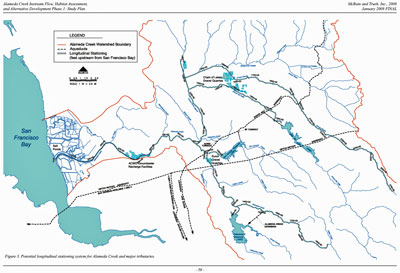What We Do >
Steelhead >
Alameda Creek
Alameda Creek Fisheries Restoration Workgroup
The possibility of restoring a run of steelhead trout to Alameda Creek has been the topic of sporadic discussion and study for over 50 years, and historical fish ladders in the watershed attest to concern for these fish even in the 19th and early 20th centuries. Restoration of steelhead trout is presently an important public priority, underscored by the 1996 listing of Central Coast steelhead as threatened pursuant to the federal Endangered Species Act.
 The Alameda Creek Fisheries Restoration Workgroup was formed in 1999 as a collaborative effort among
many parties
to pursue steelhead restoration. The Workgroup published a scientifically peer-reviewed
assessment
in 2000 that concluded suitable habitat exists in the watershed to support steelhead spawning and rearing. Since then, several barriers in the watershed have been removed, some fish passage facilities have been built and others are being planned, genetic testing of fish has been conducted, and screens installed on a major water diversion.
A Chronology of the Workgroup's activities was published in June 2013
The Alameda Creek Fisheries Restoration Workgroup was formed in 1999 as a collaborative effort among
many parties
to pursue steelhead restoration. The Workgroup published a scientifically peer-reviewed
assessment
in 2000 that concluded suitable habitat exists in the watershed to support steelhead spawning and rearing. Since then, several barriers in the watershed have been removed, some fish passage facilities have been built and others are being planned, genetic testing of fish has been conducted, and screens installed on a major water diversion.
A Chronology of the Workgroup's activities was published in June 2013
To formalize the activities of the Workgroup, and to design and conduct hydrologic studies to estimate the range, magnitude, timing, duration, frequency and location of flows necessary to restore steelhead fisheries (while minimizing the impacts to water supply operations), a
Memorandum of Understanding
was executed. This MOU has been signed by Alameda County Flood Control and Water Conservation District, Alameda County Resource Conservation District, Alameda Creek Alliance, Alameda County Water District, California State Coastal Conservancy, California Department of Fish and Game, East Bay Regional Park District, National Marine Fisheries Service, Pacific Gas and Electric Company, San Francisco Public Utilities Commission, and the Zone 7 Water Agency.
The MOU envisions three phases for the hydrologic studies. Under Phase 1 (which began in November 2006), all the relevant existing data, reports, and studies on hydrologic and geomorphic conditions and fish habitat were reviewed to prepare a plan describing the studies necessary to achieve MOU objectives. In Phase 2 these studies are to be implemented to provide the information necessary to estimate the flows for restoration. Results from this second phase will form the foundation from which specific flow proposals that would support steelhead would be considered in Phase 3 (the specific content of Phase 3 will be determined in the future).
|
